
I like to move it, move it
I like to move it, move it
I like to move it, move it
We like to move it
This “song” from the early aughts (US)/naughties (Brit) was screaming at me at full volume. I’m cringing at the inane lyrics and endless repetition.
It’s followed by a “song” from 1999 – that golden year of popular songs:
Sexbomb Sexbomb you’re a Sexbomb
You can give it to me, when I need to come along
Sexbomb sexbomb you’re my sexbomb
And baby you can turn me on.
If you’ve followed the blog for a while you’ll know I’m a fan of competitive figure skating. Sexbomb for me is Evegeny Plushenko performing a hilarious parody but to have it presented by choice, as a valid musical endeavour, and screeching at me at full volume when I’m part of a captive audience on a boat is not my idea of fun.
Witless lyrics.
Relentless beat.
I ask the DJ if he could turn the volume down a bit, but he won’t. So, being captive, I decide to just accept it, but it’s not what we signed up for, especially when we’ve been promised traditional Greek music. Surprise! You’re on a party boat!
But back to the beginning: we get the cable car down to Gialos, the old port below Fira, and watch some other boats arrive while waiting for our boat.

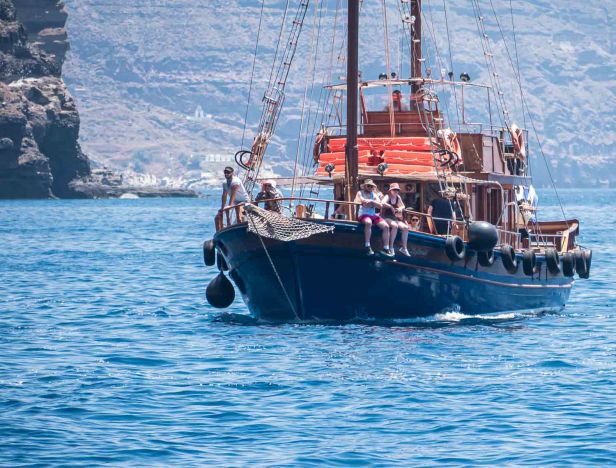

Finally Aphrodite arrives,
and we all climb aboard; it’s a sunset cruise of Santorini’s famous caldera!
Imagine a round island that’s also a volcano. Beneath the surface is a huge chamber filled with magma, or molten rock. One day, 3600 years ago, the volcano erupted sending the magma into the air. The sides and top of the volcano collapsed inwards since the magma was no longer there to support them, thus forming a caldera. If this had happened on a large land mass the remains would look like a crater, but because it happened on an island the surrounding sea immediately filled the resulting depression. This is the caldera of Santorini. All those years ago all that was left above water was the island of Santorini, and across the caldera the island of Thirasia, both part of the volcano. About 2000 years ago magma bubbled to the surface and cooled to become the island of Palea Kameni (Old Burnt Island), and then about 450 years ago from the centre of the volcano more magma was released to become the island of Nea Kameni (New Burnt Island). There’s one other tiny island in the caldera, Aspronisi, that is also one of the remnants of the original round island volcano. The volcano’s most recent eruption was in 1950. It is still active. Nea Kameni is known by locals simply as the volcano.
Any time I’m on a boat I’m happy, even with the blaring of unfortunate music. After a quick twenty minutes we reach the first stop, Nea Kameni,
where we have one and a half hours to explore this National Geological Park. It is a harsh, stark place,
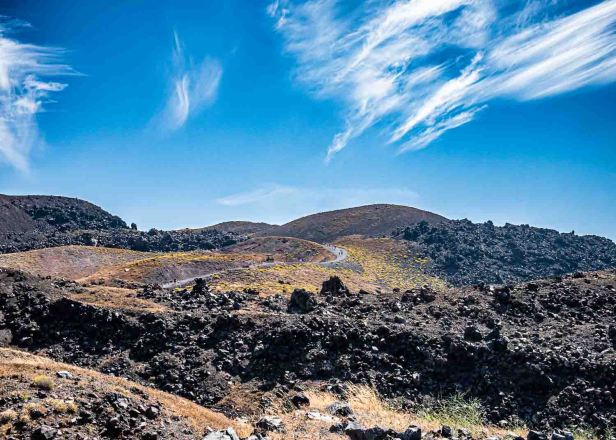
this small island of volcanic rock with spectacular views. Not much grows here, though to my utter delight we come across carpets of yellow wildflowers,

and a view back to Fira on the main island of Santorini. On our first day in Santorini we walked down that zig-zag staircase to Gialos, the tiny port by the water snugged up close against the rocky cliff.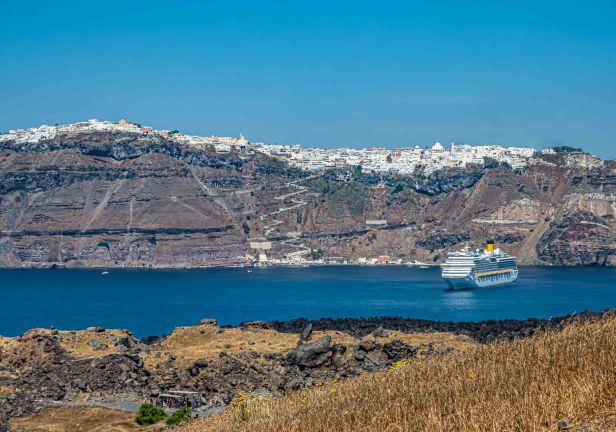
After hiking to the top of Nea Kameni we are soon back on the boat and headed for the next stop. It’s Palea Kameni.
Near the centre of this island, accessible from a small beach, is a hot spring warmed from the molten rock below. As it’s a tough thirty-metre swim to get there we stay on the boat, and it’s then that I discover Sostis Arvanitis, though I know nothing of him at the time. All I can see is that someone (or someones) live here in this little encampment of fishing boats by this rocky isolated uninhabited shore. There also seems to be a small building, and nearby there’s a diminutive white church.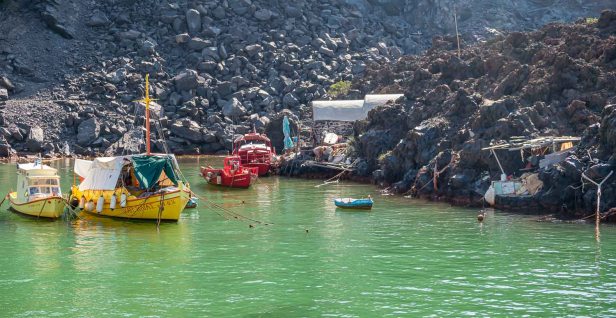
I’m not much interested in the church. But oh this little camp of fishing boats and that small structure built into the cliff – that fascinates me.
Off to one side there’s a collection of “stuff”, handy treasures no doubt – ropes, various plastic barrels and containers, canvas tarps – all of it with a dilapidated “roof”. What is it all? Who does it belong to, and why?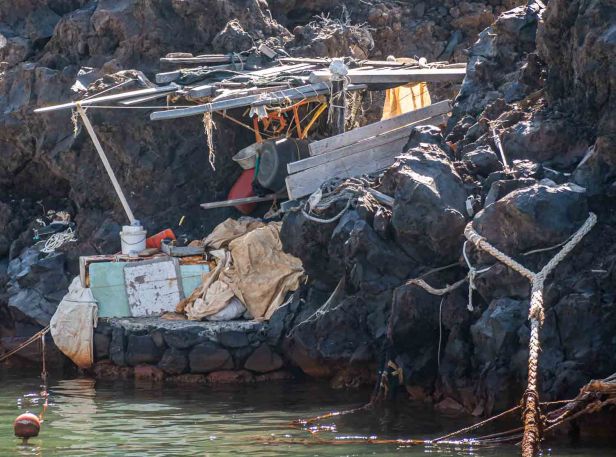
Then there are the two pairs of boats, one yellow pair anchored off shore a bit,

and two red ones anchored at the “dock” right next to the small building. And I see I’ve also captured an elderly gentleman.
It took some internet sleuthing to discover what I was looking at. It’s the home of a (somewhat, but not completely) hermit named Sostis Arvanitis and his giant German shepherd, and all I can say is that I wish we had taken a tour of the caldera with him on one of his fishing boats. He does tours from time to time, but only if he likes you, and only if he feels like it. In his sixties, this fisherman and ex-sailor has chickens, and goats that he milks for making feta, and he grows various vegetables in the rich volcanic soil. Reports say he’s the only human inhabitant of the island, leaving behind his “trouble with women – she tried to kill me”, but I notice there’s a woman in one of the yellow boats. A visitor? Or perhaps he’s changed his mind about women. It happens. When you meet the right one.
It’s so surreal. Just across the water are the towns of Fira and Oia, host each year to 2 million tourists and hundreds of cruise ships, a world of excess, of conspicuous consumerism, of bucket-list excursions. And here is this man who chose a quiet simple unencumbered life alone in one of the most beautiful places in the world.
Leaving Palea Kameni we sail for a while. The music is less intrusive, and it feels truly exhilarating and joyous being on the water as the boat moves along.
There’s another swimming stop,


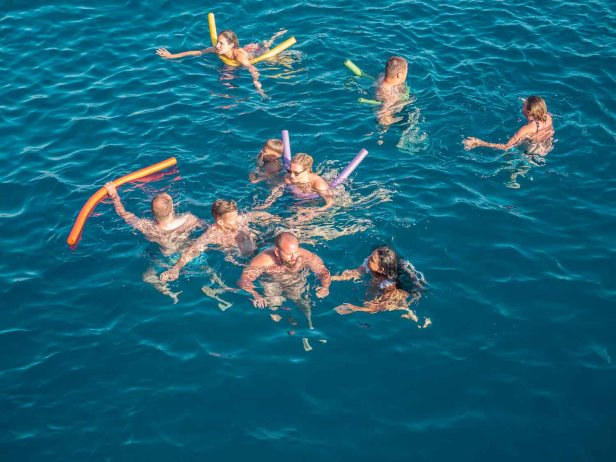
and then we anchor off the island of Thirasia as dinner is served.

From my notes: pretty awful really, and dessert’s a huge disappointment – small semolina squares and orange wedges. Also there’s not enough for everyone, let alone the seconds they promised us. But the music improves – finally the traditional Greek music we’ve been promised.
From Don’s notes: We were slow getting into line. By the time we get to the Greek salad it’s 95% tomatoes. The rest of the meal is not much better: some vegetables, dried out chicken cooked in some unnameable sauce, and meat balls. The tzatziki is nice. We get a glass of wine to go with the meal. Dessert: slices of fresh orange, and pieces of that awful semolina cake, which we both ignore.
And more from Don: Carrying our minimalist desserts back to our seats we are waylaid by the group of four sitting behind us, who insist that we join them at their table. This turns out to be one of the best parts of the trip: they are two American couples, long-time friends from New Jersey, who have just had two weeks holiday on Santorini.
And from my notes: I don’t mind about the music so much because we sit with Jerry and Annie, and Steven and Rosemary, and have a fabulous time with them. They are all so much fun. Don especially has a very lovely connection with Jerry – on some level those two understand each other immediately; Annie and I get up and do the Zorba dance in the aisle; we laugh, we chat; we cut loose! Don and I cut loose! We’re so used to it being just the two of us that we forget what fun it is to get together and be sociable and talk and laugh and party with some like-minded people.
I finally start partying on the party boat!
As we come nearer to Oia, the village at the north end of crescent-shaped Santorini,

the engine is slowed, the sails are hoisted,
and the mood and music changes again to something gentle and soothing. It’s nearly time for the sun to set, and most would have it that this is the main purpose of the trip.
There’s this whole thing about Santorini’s sunsets, which has reached just about mythical status. It’s one of a handful of places in the world where people gather by the thousands to watch it, and as the sun drops below the horizon there is spontaneous applause. In the high season the village becomes packed with people all crowded together to get the best view – from the castle ruins, from restaurants with a sunset view, from cars double-parked all the way along the road down to the dock below the town.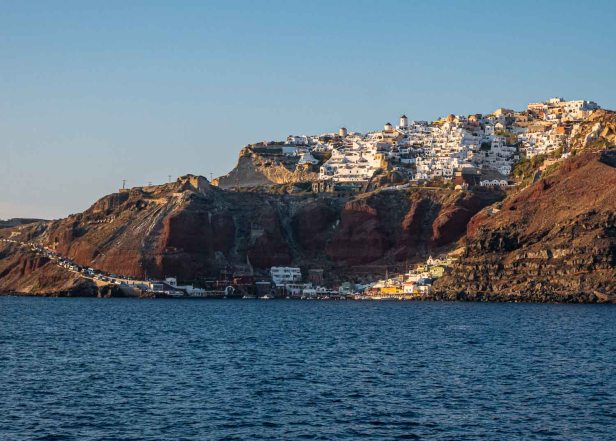
No doubt it’s a lovely sunset,
but I don’t get the hype, which I suspect comes more from the idea that sunset is the thing to do on Santorini. Go to Santorini, have fancy meals and drinks and gaze at the view, then watch the sunset with a few thousand other people. Honestly I’m not that jaded. I’m sure if I’d been in amongst the thousands gathered onshore I’d have applauded along with the rest and caught the simple camaraderie and shared joy of the moment. But I’ve seen better sunsets.

The events of the cruise are complete and slowly the boat starts to move again. We have one last look at the village of Oia sprinkled along the clifftop like sugar,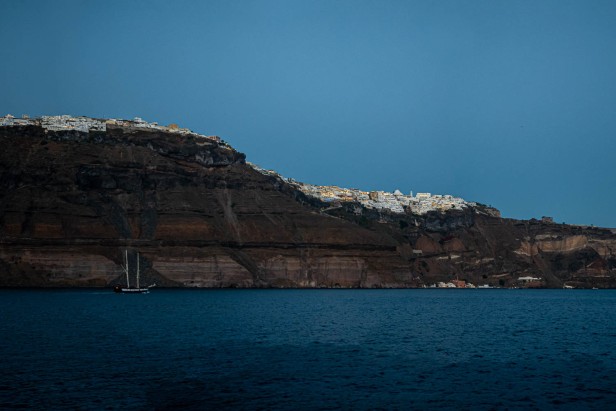
and then it’s a straight shot along the coast to Fira. We rejoin the New Jersey Four and chat and laugh and party our way back. It’s been a slice.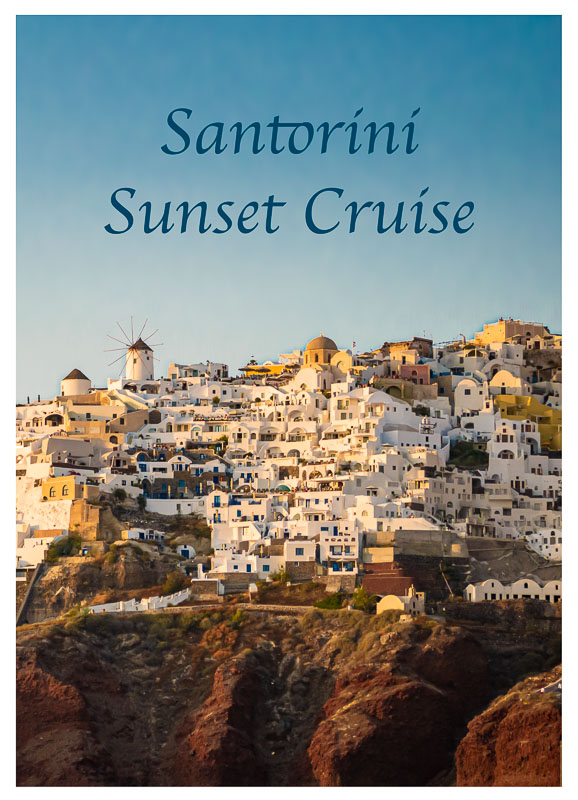
Next post: From Santorini we journey by ferry to the island of Naxos, our next stop island hopping in the Cyclades.
All words and images by Alison Louise Armstrong unless otherwise noted
© Alison Louise Armstrong and Adventures in Wonderland – a pilgrimage of the heart, 2010-2023.

Nea Kameni looks my kind of place, Alison. Sunset cruises do vary but there can be few more spectacular settings. I loved Naxos 😍
LikeLiked by 1 person
We enjoyed scrambling all over Nea Kameni – stark landscape. I have experienced that sunset cruises vary according to how much you pay 😂
We did an all-day cruise around Milos – probably paid a lot more but it was fabulous from start to finish. This one in Santorini was def the low-cost tourist ride.
Alison
LikeLiked by 1 person
Oh wow, an almost hermit. Love the idea of a tour with him. Glad you finally ‘came’ to the party. hahaha
LikeLiked by 1 person
It took me a while to start partying, but I got there. We both had so much fun with the New Jersey Four.
I found Sostis’ story fascinating. Hard to find info – mainly from blog posts by people sailing around the Mediterranean, etc. By all accounts when he’s in the mood he’s personable and sociable and enjoys company, but def likes his isolated life. I’m so curious about the woman in the yellow boat – they are his boats for sure. Maybe he’s renting them to another (almost) hermit 😁
Alison
LikeLiked by 1 person
I love seeing the world of Santorini through your eyes and camera lens. Excellent post – commentary, images and music, too!
LikeLiked by 1 person
Thank you so much Babsje, I’m so glad you enjoyed it. It was a fun post to put together; Santorini is pretty magic for sure.
Alison
LikeLiked by 1 person
I love all your photos Alison and Don🥰
LikeLiked by 1 person
Thanks so much Arlene. Glad you enjoyed them.
Alison 🤗
LikeLiked by 1 person
The hermit story is hilarious. What a character. We accidentally booked a couple of party cruises in Brazil, so I know that initial feeling of ‘oh no…’ But you did get some amazing views of the islands. Maggie
LikeLiked by 1 person
I’m so glad the party music didn’t last for the whole trip. Also I think it was turned down, or off, during the swimming stops. Otherwise I’d have been tearing my hair out. Or dancing a lot 😂
We got some fabulous views, and the hermit was a bonus for sure. I don’t think anyone else on the boat noticed or cared, but I’m always curious about the locals, and anything different.
Alison
LikeLiked by 1 person
What a fabulous adventure and great pics. Love the background on the volcanoes.
LikeLiked by 1 person
Thanks so much Algeria. I knew I needed to look into the whole volcano situation because all the local people continually referred to the water as the caldera and I wanted to understand why. Glad you enjoyed it.
Alison
LikeLiked by 1 person
Great post! Couldn’t leave a comment for some reason or other… Xox
>
LikeLiked by 1 person
Thanks Surati. It was a good day out for sure.
Did you try to leave some other comment? Anyway this one arrived.
Alison xo
LikeLike
Apart from the occasional obnoxious music, it sounds like a pretty nice day out. The weather looked good, the sea looked great, and there’s a certain magic to making new friends, albeit temporary ones, on an adventure.
LikeLiked by 1 person
You got it exactly right – apart from the awful music at the beginning it was a very nice day out. Can’t beat the location for beauty, and the weather was our friend for sure. And we had so much fun with the New Jersey Four – so altogether it was a great way to experience a bit more of what Santorini has to offer. The food was pretty dire though 😂
Alison
LikeLiked by 1 person
Wonderful as usual you two. Love you.
LikeLiked by 1 person
Thanks. C U soon
Love back
Ali xo
LikeLike
The volcanic islands remind me very much of some of the islands in the Galapagos – lots of volcanic rock, scrubby, not much by way of vegetation. Your cruise music is horrible, as is the food. Thank goodness for the New Jersey 4! And the hermit – now HE would be a fantastic tour guide. He’d love you, I’m sure. 😀
LikeLiked by 1 person
I hadn’t thought of the Galapagos, but you’re right – similar volcanic landscape. Yeah – music and food pretty awful, but at least the awful music was only at the beginning, and then we met the NJ 4 and that was fun! Plus the hermit – I was so fascinated, and took many photos of that little encampment. I’m so glad I could find out about it. That Sostis is quite a guy. I hope he’d love us; if we ever get back to Santorini I’d look into a cruise with him for sure.
Alison
LikeLiked by 1 person
This is hilarious, and I would be right alongside you complaining and then understanding you have to go with the flow… “promised traditional Greek music. Surprise! You’re on a party boat!” And while the music was not too inspiring… wow, to the sight seen from your photographs 🙂 It would have been interesting if you could have gotten a tour with the hermit, Sostis Arvanitis… imagine the stories he would have to tell. I think you’d two get along pretty well. And it was a joy to read how not only you finally got to hear some Greek music ~ but, as with all travel, met special people as well. The sunset photos are amazing, but I think you probably see just as awesome views up in Vancouver 🙂 Cheers, and many happy more travels to you both!
LikeLiked by 1 person
Thanks so much Dalo. The sunset was really lovely, I guess I’d been expecting something out-of-this-world spectacular given the hype. Darn hype! Get’s you every time 😂
On the other hand the scenery really lived up to the hype – it’s a truly unique and beautiful place.
I would almost consider a return trip to Santorini to get to hang our with Sostis. I found a couple of blog posts about him, and a newspaper article (The Guardian maybe?) – by all accounts he’s personable and friendly and seems to enjoy company – when it suits him. He seems to have found the perfect balance for him.
And of course meeting the NJ4 was fun – one of the best parts of travel.
Alison
LikeLike
The hermit certainly is intriguing, how he manages to live and feed himself well on this piece of rock! Partying with the NJ4 sounds like a blast.
LikeLiked by 1 person
I was fascinated by the hermit. Well at the time I didn’t know he was a hermit; apparently he’s a good guy to hang out with, but he very much sets him own agenda. But seeing that encampment was really fascinating and being “nebby” as Don put’s it, I wanted to know all about it. He keeps goats, makes his own feta, grows vegetables, fishes. But he must have some small income source – maybe from tours, maybe a pension? Also presumably there’s a fresh water source somewhere. No-one else on the boat was interested, probably didn’t even notice it.
The experience we had with the NJ4 is one of the best parts of travel. So much fun!
Alison
LikeLike
How fantastic!
LikeLiked by 1 person
Yes! It really was! All of it, even the dire music once I surrendered to it 😂
Alison
LikeLike
Very off-topic (sort of), but I had to look up “nebby” because my dad always said that and, as you might remember, his family was from almost the exact same place in northern England as Don. Indeed, it’s a Scots-Irish term, but my main point after all this etymology is that I am so nebby myself, and I would have been all over that hermit story. 🙂 Thanks for filling us in!
Back to the party boat … in spite of the atrocious music and food (both of which I have experienced on a Greek boat), the cruise looks idyllic in many other ways. I think my favorite photos are two in a row near the end – the golden hour view of Oia and the sails. Glorious! Worth the annoyances just for those, in my opinion.
LikeLiked by 1 person
Nebby’s a great word, and I’m not surprised to hear you’re also nebby. It’s what travelling’s all about. I just had to know what that completely random little collection of boats was all about.
You’re right – the cruise was quite wonderful in so many ways, food and music notwithstanding.
I’m glad you like the sails – I took many shots looking up at them and this one seemed to capture it best. That was a lovely and unexpected moment when they hoisted the sails. And yes, not much can compare to golden hour Oia.
Santorini’s an amazing place, more wonderful than we expected given the hype, but also we came to understand the hype and why so many flock there.
Alison
LikeLiked by 1 person
Oh Santorini! 23 years ago me and Paul spent five lovely days there on our honeymoon. It was unforgettable and my favorite Greek island. I loved sitting high above outside on the patio of our hotel overlooking the caldera. What a dreamy place. Beautiful photos and words Alison . hope all is well!
LikeLiked by 1 person
Thanks Nicole. I can’t even imagine what Santorini would have been like 25 years ago. It must have been so idyllic. A dreamy place indeed, something really special about it for sure.
All is well. Don continues to improve, almost back to his normal self. We’ve been so lucky.
I have your 2 latest posts from Bhutan lined up to read!
Alison
LikeLike